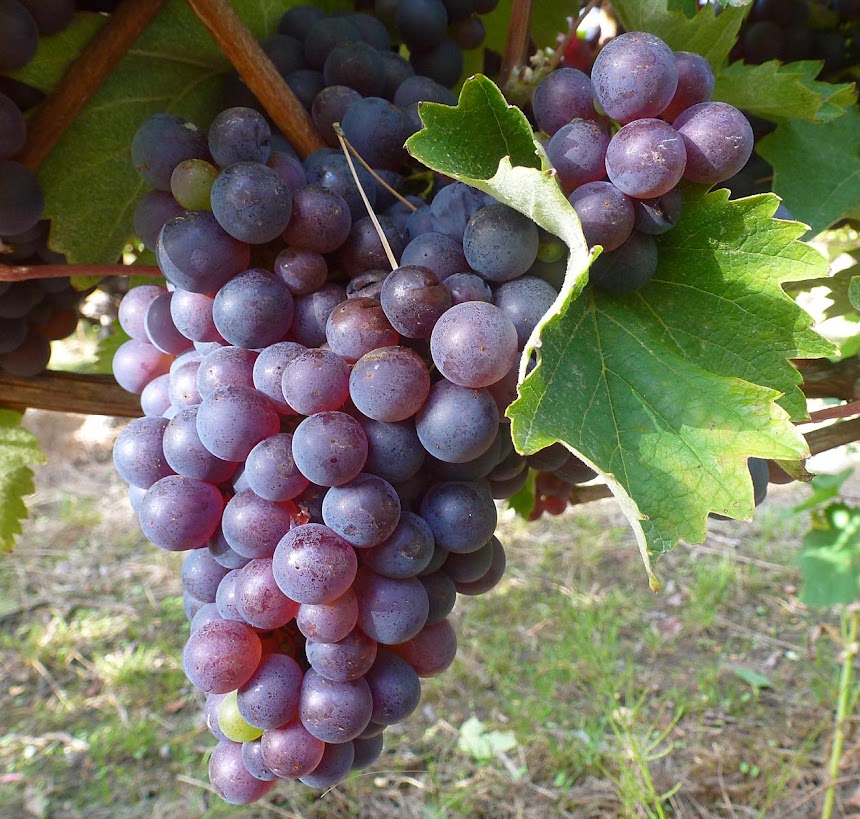That would be poulet à la basquaise, or à la mode basquaise — Basque-style. A friend who lives a few miles up the river from us grew piments d'Espelette, a Basque specialty, in her garden this year. Generous as she is, she brought us some a day or two ago. The piments are hot red peppers, which came originally from South America but were brought to Basque country centuries ago and became popular there.
The other ingredients in Basque-style chicken are garlic, onion, red or green bell peppers, tomatoes, and chicken. It's a very simple but very tasty way to make braised chicken. I'll post the recipe at the end — scroll down.
The first step is to cut up a chicken, unless you decide to buy chicken parts. I had eight pieces — two drumsticks, two thighs, and four pieces of breast, wings still attached. Make broth with the carcass and trimmings. Brown the serving pieces in a big pan or pot and put them in the oven to stay warm while you make the sauce.
Slice up four onions (half a pound, 250 grams), four garlic cloves, one bell pepper (or more), and some piments d'Espelette or other hot red peppers if you can get them. If not, put in two or three sliced bell peppers and add some cayenne or other hot red pepper powder to spice up the sauce. Sauté the sliced onions, peppers, and garlic cloves in olive oil for a few minutes.
Cut up a kilo of fresh tomatoes — that's about 2 lbs. — into big chunks and add them to the pan. Turn up the heat and stir everything together. (Use good canned tomatoes if you don't have fresh ones.)
Turn the heat down to medium and let it all cook for at least 15, if not 20, minutes, covered. Add some white wine or chicken broth if it needs liquid, and put in three bay leaves and a teaspoon or so of dried thyme, along with salt and black pepper.
Meanwhile, here are the chicken pieces after they've been lightly browned. They've been sitting in a warm oven for 15 or 20 minutes at this point.
And here is the sauce after it's been cooking for a few minutes. It's ready to have the chicken placed on top. Do that, put the lid back on, and let the pan bubble and simmer for 30 to 45 minutes, until the chicken is done the way you like it. Serve with rice.
Here's what the fresh piments d'Espelette look like. Actually, they are the four longer ones in the center of the bowl, and are the ones I used for the Basque dish. I cleaned them and got rid of the ribs and seeds. I'm glad I did, because they were plenty hot without all that. The other peppers are a different variety, called piments de Bresse. We haven't tried them yet.

Poulet basquaise
1 chicken (or about 2½ lbs. of chicken parts)
½ lb. (250 grams) onions
4 cloves garlic
1 or 2 bell peppers
2¼ lbs. (1000 grams) tomatoes
4 hot red peppers (Espelettes if you can get them)
white wine or chicken broth as needed
olive oil
salt and pepper
thyme and bay leaves
1 chicken (or about 2½ lbs. of chicken parts)
½ lb. (250 grams) onions
4 cloves garlic
1 or 2 bell peppers
2¼ lbs. (1000 grams) tomatoes
4 hot red peppers (Espelettes if you can get them)
white wine or chicken broth as needed
olive oil
salt and pepper
thyme and bay leaves
Cut the chicken up into serving pieces. Slice the onions, garlic, and peppers (ribs and seeds removed). Trim and cut up the tomatoes.
Sauté the chicken pieces, skin side down to start with, in olive oil until they are lightly browned. Turn them over several times as they cook and season them with salt and pepper. Put them on a plate or platter and keep them in a warm oven while the sauce is cooking.
Sauté the sliced onion, garlic, and peppers in olive oil for about 5 minutes. Then add the chopped tomato to the pan and stir well. Add the thyme and bay leaves, and some salt and pepper. Cover the pan and let the tomatoes cook for 15 or 20 minutes. Add white wine or chicken broth if the sauce needs liquid.
Lay the chicken pieces over the sauce, pushing them in so they're partially covered. Put the lid back on the pan and let it cook for 30 to 45 minutes, until the chicken is done to your taste. Serve with rice.
Sauté the chicken pieces, skin side down to start with, in olive oil until they are lightly browned. Turn them over several times as they cook and season them with salt and pepper. Put them on a plate or platter and keep them in a warm oven while the sauce is cooking.
Sauté the sliced onion, garlic, and peppers in olive oil for about 5 minutes. Then add the chopped tomato to the pan and stir well. Add the thyme and bay leaves, and some salt and pepper. Cover the pan and let the tomatoes cook for 15 or 20 minutes. Add white wine or chicken broth if the sauce needs liquid.
Lay the chicken pieces over the sauce, pushing them in so they're partially covered. Put the lid back on the pan and let it cook for 30 to 45 minutes, until the chicken is done to your taste. Serve with rice.
Here is the recipe in French. Some recipes I've seen add mushrooms, olives (green and black), or chunks of smoked ham (or lardons) to the sauce, but I wanted to keep it simple.

















































